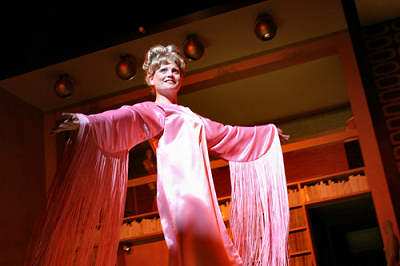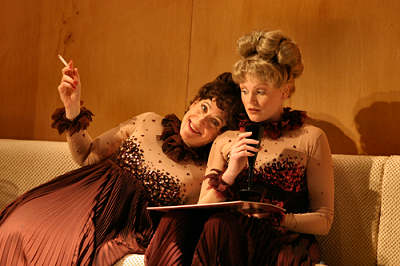Gerald Barry: The Bitter Tears
of Petra von Kant (World Stage Premiére of the RTÉ/ENO co-commision),
Petra von Kant: Stephanie Friede, Sidonie von Grasenabb: Susan
Bickley, Valerie von Kant: Kathryn Harries, Gabriele von Kant:
Barbara Hannigan, Karen Thimm: Rebecca von Lipinski, Marlene:
Linda Kitchen, Richard Jones (director), André Ridder (conductor),
ENO at the Coliseum, London, 16 September, 2005
(AO)

ENO may have a hit on their
hands, judging by the audience reaction to this new opera. It's
a gamble to start a new season with new music but with this
production they may have found a winning formula.
Barry may be Ireland's best-known contemporary composer,
but even the programme notes state that “his recent work seems
more marginal to the studied ways of new music than ever.”
ENO's sponsorship of Brian Ferneyhough's Shadowtime
showed real vision, but was perhaps a “bridge too far”. No such
worries with Barry's Petra
von Kant: it is modernism made palatable.
The programme continues
“Barry doesn't want to épater les bourgeois or pass a
mordant comment on society. What he wants is to restore the bright colours
of the world, the ones the child knows.”
The opera bursts with exuberance. Its
colours are the strident oranges and yellows of the 1970's,
“the decade that taste forgot”.
Barry wanted the 70's idiom because it captures the claustrophobic
mood of the original play and film by Rainer Werner Fassbinder.
The set and costumes, by Ultz, are brilliant for they capture
the 70's with a vengeance – unsubtle garments, reel-to-reel
tape-decks, pink telephones. For Fassbinder, the 70's imagery
identified Petra von Kant as a symbol of the post-war German
economic boom. She chases
material success with a mania, in order to avoid facing deep
traumas in her past. Barry didn't watch the film because he wanted
to respond directly to the play on his own terms, so his music
does not make much of the political undercurrents. The design
reflects his interpretation of the play as a drama of love,
alienation and post- modern irony. Indeed, it seems so universal that it comes
as a shock when Marlene puts up bunting that says “Herzlichen
Gluckwünsche”, “Happy Birthday”. Perhaps Ultz is making a very subtle play on
the word “Herz”, to underline Petra's heartbreak. I loved that touch.
Here are the bare bones of the plot. Petra is a fashion designer
who seems to have it all, a winner in a man's world. This production makes much of her cruelty to
her secretary, but the inner Petra is a generous soul who gives
her mother money which she can't really spare herself.
Thus she falls hopelessly in love with Karin, a bimbo
completely her opposite. It's
as if she's seeking to find what she is not.
Karin goes back to her ex husband and Petra collapses
in drunken grief to the horror of her family. Nonetheless, the
heartbreak proves a breakthrough, and in the end she understands
herself better. She was
right about Marlene, her secretary, who was a slave “because
she likes it” - Marlene turns out to have been as crazy for
Petra as Petra was for Karin. In the libretto, there are many nuances to
explore – the role of women in society, different forms of love,
social hollowness. Barry
pays careful attention to the verbal cadences of the text:
his music reflects the modulations of speech, particularly
that of Petra's daughter, who is portrayed in charmingly wobbly
high notes which almost fly off key.
When mother and daughter have a moment of closeness,
the orchestra falls silent, as if not to intervene.

But Barry's main interest seems to be the fast spaced
vigour of the text, rather than its ambivalent undertones.
The bright colours and simplified shapes of 70's design
seem to define the music itself.
Loud, harsh brass and percussion dominate.
Motifs are interesting, and repeated like the wallpaper
in Petra's bedroom – big, simple figures repeated endlessly
without much variation. Like the wallpaper, the overall effect is definitely
striking, and very “modern” as the designs did appear in a world
more used to chintz and ormolu.
There are many witty touches, for example, the hint of
Germanic brass bands in the passage where there is no text to
be sung.
This music could almost have been written with Richard
Jones in mind. It suits
his style perfectly. He carries off the most dramatic visual games
with an almost comic book simplicity which fits in with Barry's
bright colours and simple shapes.
When Petra wonders what outfit to wear, a light bulb
lights up above her head, just like a cartoon “Thinks”. As she
waits longingly for Karin to return, her TV set shows a clock,
it's face turning – a device straight out of the movies. If it depicted days, rather than hours, it might
be an old fashioned calendar, with leaves falling off. When
Petra kisses Karin for the first time the music rises into a
crescendo and suddenly the lights go out – another cinematic
hint, like cutting to images of surf pounding a beach, or, less
appropriately in this case, a train in a tunnel. The music and visual jokes fitted so well, that
the audience loved it. Some
were even uninhibited enough to burst out laughing!
The performances were superb.
Stephanie Freide's Petra is a tour de force and she sings
throughout with hardly a break.
Moreover the role calls for acting skills beyond the
usual call of duty. She has to emote her character sympathetically,
bringing out depths of characterization without much help from
the music. That Petra comes across as a far more complex
personality is in many ways thanks to her portrayal. Karin Thimm, too, was portrayed by Rebecca von
Lipinski with much more discreet intelligence than the feckless
Lulu personality might merit.
Ironically, Karin is “common”, as Petra's daughter says,
but in real life, von Lipinski has the pedigree!
All five actresses flesh out cardboard
cut-outs. Jones fastened
on the imagery of mannequins as an allegory for womanhood. Mannequins are lifeless, no use for anything
but displaying clothes for sale.
The emphasis on 70's fashion values thus makes sense,
for 70's women were expected to act like shop dummies, “selling”
themselves as consumer goods. All those wigs, false eyelashes, and unflattering
clothes turned women into caricatures. No wonder drag acts love the 70's, for the decade
was so unreal.
This opera is very much a joint effort involving
performers, director, designer and composer (and all the other
behind the scenes people who make it possible).
What Fassbinder would have felt about his play getting
the opera bouffe treatment, I don't know. But on its own terms, this works. Ferneyhough's Shadowtime will probably be appreciated in generations to come.
But Petra von Kant, at least in this production, will do what opera was
originally meant to do: amuse and entertain, with an edge of
wit. And if it brings audiences to ENO and to modern
music, all the better.
Anne Ozorio
Pictures: Stephanie Friede (Petra von Kant) / Rebecca von Lipinski
(Karin) Photographer: Stephen Vaughan © 2005




